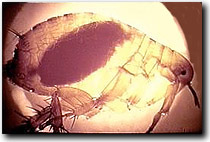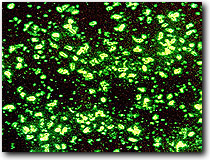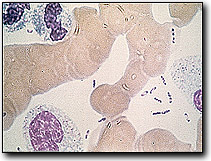 |
|
|
 |
||
|
||||||||||||||
|
This material is available primarily for archival purposes. Telephone numbers or other contact information may be out of date; please see current contact information at media contacts.
Human Plague Cases Increasing In Southwest
Human plague, that dreaded disease of centuries past caused by the bacterium Yersinia pestis, is on the rise, at least in the southwestern United States. Biologists at the National Science Foundation (NSF)-funded LongTerm Ecological Research (LTER) site in Sevilleta, New Mexico, have found that human plague cases in New Mexico occurred more frequently after wetter than average winter-spring time periods (October to May). In fact, during years much wetter than normal, a 60% rise in the number of cases of human plague resulted. The scientists report these results in a paper published in the November issue of the American Journal of Tropical Medicine and Hygiene. Plague occurs episodically in many parts of the world, explains Robert Parmenter, director of the Sevilleta LTER field research station, and lead author of the paper. "Some outbreaks appear to be related to increased abundance of rodents and other mammals that serve as hosts for the fleas that then transmit the disease to humans." Increased winter-spring precipitation, say Parmenter and his colleague Ken Gage of the Center for Disease Control office in Fort Collins, Colorado, enhances small mammal food resources (plants and insects), leading to an increase in the abundance of plague hosts. In addition, moister climate conditions may act to promote flea survival and reproduction, also enhancing plague transmission. "Our results can be used by physicians and public health personnel to identify and predict periods of increased risk of plague transmission to humans," Parmenter hopes. Global climate dynamics are proposed by some scientists as the culprit in recent outbreaks of infectious diseases; others warn that long-term global warming could increase the risk of contracting such diseases. "The recent El Nino events of the 1990s have been associated with large increases in rodent populations in both North and South America," explains Scott Collins, LTER program director at NSF. "These increases in rodent populations have been shown to correlate with numerous diseases, including Lyme disease and hantavirus pulmonary syndrome. Climate studies may provide a forecasting tool for identifying periods of increased risk of disease transmission." Plague was introduced into North America via San Francisco, California, in 1899-1900 by shipboard transport of plague-infected rats from Asia. These rats quickly infected native mammal populations, especially ground squirrels, and plague spread throughout western North America. Plague is now most commonly found in the southwestern United States -- in New Mexico, Colorado, Arizona and California. Major risk factors for humans include contact with diseased wild mammals or their infected fleas, and exposure to infected fleas carried by pets like dogs and cats. "If climate conditions become favorable for reproduction and survival of either the wild mammal populations or their flea populations, then the probability of human infection via animal-fleahuman contacts will also increase," write Parmenter and his colleagues. With known risk of plague transmission following unusually moist winter-spring seasons, localized public health warnings and heightened medical surveillance can be arranged prior to the peak in human cases during the summer, the scientists suggest. "Local physicians and health care professionals can determine if their cities and towns have received higher-than-normal precipitation, and increase their cognizance for plague patients," the researchers write.
Editors: Images of the plague bacterium are available at a resolution of 200 dpi. Please contact Peter West at: 703-306-1070/pwest@nsf.gov Broadcasters: B-roll is available on Betacam SP. Please contact Dena Headlee at: 703-306-1070/dheadlee@nsf.gov or pager: 1-888-937-5249
| ||||||||||||||
|
|
||||||||||||||
| |


